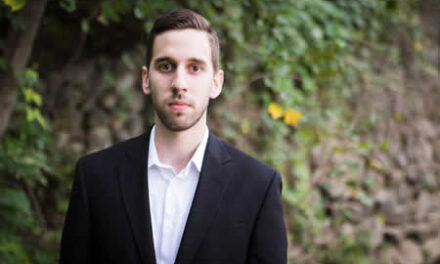Very few empty seats were visible in Baldwin Auditorium on the East Campus of Duke University for the welcome return of Richard Goode for the first concert of Duke Performances’ Piano Recital Series. The renowned musician’s earlier appearance had been in far less inviting confines of Page Auditorium. With the passing of the Adams Foundation, which funded recitals nationally, such series as Duke’s are even more important in their roles against the trend of vanishing recitals.
Goode’s imaginative program surveyed two giants of the First Viennese School of Music, Ludwig van Beethoven (1770-1827) and Franz Schubert (1797-1828), leavened with a truly concentrated piece by Arnold Schoenberg (1874-1951), of the Second Viennese School.
Beethoven’s Sonata No. 10 in G, Op. 14, No. 2, opened the program. This sunny sonata finds the composer in good spirits. There is no true slow movement among its three. The composer plays with the phrasing and accents of his themes throughout. The opening Allegro features both rhythmic elasticity and a dialog between the two hands. The composer toys with dissonance and broken chords. The Andante features tension between a naïve theme and its sophisticated variations. Beethoven’s Haydn-like humor is found in the fortissimo outburst of the final chord. The unusually designated Scherzo-Allegro assai finale is filled with disruptive chords and humorous rapid passage work.
Goode brought out all the infectious humor Beethoven packed into this delightful and ebullient sonata. A beautiful tone was combined with a finely graduated dynamic palette. Goode’s articulation throughout this recital was simply breathtaking.
Schubert’s last three piano sonatas (Nos. 19-21) were composed within a remarkably short period of time, his last three months of life in 1828! The composer’s late songs showed a tendency toward greater concentration whereas his larger instrumental works found greater and greater spaciousness. This is certainly true of these great piano sonatas, which were slow to win critical acclaim because of their sprawling melodiousness and the composer’s large scale approach to structure.
The least known of the final three, Sonata No. 19 in C Minor, D. 958, ended the first half of this recital. Its tone is unrelievedly dark but is both powerful and very individual. Highlights of the opening Allegro are downward-rushing scales, unexpected chromatic touches, and agitated modulations. The unusually vigorous Menuetto: Allegro has mysterious silent bars near the end and a trio section that is a wistful Ländler. The extensive Allegro finale features three loosely bound themes – one dancing, one dramatic, one lyrical – before ending in a brilliant finish.
Schubert’s Sonata No. 20 in A, D.959, which ended the recital, certainly could earn Robert Schumann’s description of the great C Major Symphony: of “heavenly length.” It is more evenly proportioned than D.958 and more varied in tone. The opening Allegro juxtaposes the majestic opening chords against one of the composer’s simplest and most winning melodies.Wholly new ideas are added in the development. A three-part Andantino follows with a melancholy, barcarolle-like melody leading to an intense, tumultuous episode with chromaticism of various types before ending with an ornamented version of the opening theme. The opening of the Scherzo is sunny before the music is suddenly wrenched from C to C-sharp Minor in a hectic episode before a return to the opening mood. The finale, Rondo: Allegretto, considered one of Schubert’s finest, has a breadth and strength which is a contrast with the usual fast paced excitement of such movements.
Goode’s interpretation and playing of these two late Schubert sonatas was nothing short of magnificent. His ability to hold so many elements that could easily seem episodic into a whole conception was remarkable. The clarity of his articulation, his refined attention to dynamics, and his control of color and rhythm were superb.
Only a curmudgeon could have complained about Goode’s spicing up the recital with the Six Little Piano Pieces, Op. 19, by Schoenberg, which opened the second half of the concert. Barely a little over five minutes long in total, you could have missed at least one during a loud sneeze. There is an almost Webernian concentration about these fleeting works, which range from what Paolo Petazzi (in CD program notes for Schoenberg: The Piano Music) describes as “one long, whispered pianissimo” to “a chill, insubstantial timbre which hovers on the edge of silence.” No. 6, nine bars long, was intended as an homage to Mahler, who had passed away a month earlier in May, 1911.
Goode made the best possible case for these incredibly distilled works. His refined approach to color and dynamics repaid dividends.











